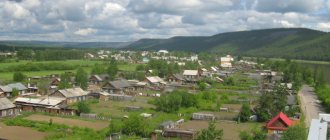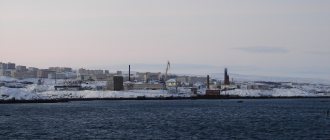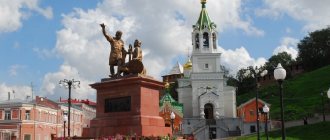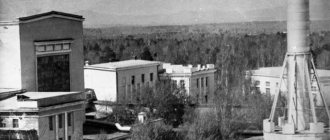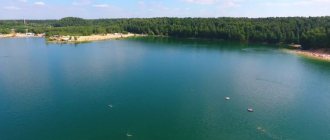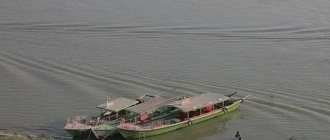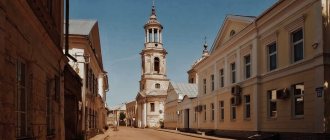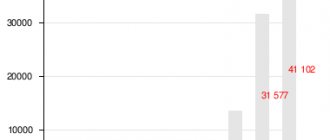This term has other meanings, see Kushva (meanings).
| The style of this article is non-encyclopedic or violates the norms of the Russian language. The article should be corrected according to Wikipedia's stylistic rules. |
| This article or section needs revision. Please improve the article in accordance with the rules for writing articles. |
| City Kushva
| Coat of arms |
| A country | Russia, Russia |
| Subject of the federation | Sverdlovsk regionSverdlovsk region |
| Urban district | Kushvinsky |
| Coordinates | 58°17′00″ n. w. 59°44′00″ E. d. / 58.28333° n. w. 59.73333° E. d. / 58.28333; 59.73333 (G) [www.openstreetmap.org/?mlat=58.28333&mlon=59.73333&zoom=13 (O)] (Z)Coordinates: 58°17′00″ N. w. 59°44′00″ E. d. / 58.28333° n. w. 59.73333° E. d. / 58.28333; 59.73333 (G) [www.openstreetmap.org/?mlat=58.28333&mlon=59.73333&zoom=13 (O)] (I) |
| Based | in 1735 |
| Former names | until 1926 - Kushvinsky Plant |
| City with | 1925 |
| Population | ↘28,819[1] people (2016) |
| National composition | mostly Russians |
| Confessional composition | atheists |
| Names of residents | Kushvintsy, Kushvinets |
| Timezone | UTC+5 |
| Telephone code | +7 34344 |
| Vehicle code | 66, 96, 196 |
| OKATO code | [classif.spb.ru/classificators/view/okt.php?st=A&kr=1&kod=65470 65 470] |
| Subordination | Regional |
| Awards |
| Kushva Moscow |
Ekaterinburg Kushva |
Audio, photo and video
on Wikimedia Commons
K: Settlements founded in 1735
Kushva
(Komi-Permyak - “rotten water”) - a city (since 1925) in Russia, regional subordination of the Sverdlovsk region northwest of Yekaterinburg and Nizhny Tagil. Administrative center of the Kushvinsky urban district.
Geography
The city of regional subordination is located around Mount Blagodat on the Kushva River, 198 km north-west of the regional center of Yekaterinburg and 50 km north-west of Nizhny Tagil, at the point of separation of two railways Yekaterinburg - Priobye and Yekaterinburg - Perm (Gornozavodskaya railway) . The railway junction consists of three stations: passenger Goroblagodatskaya (popular abbreviation “GBD”), where there is a large station and a small station Blagodati and cargo and passenger station Kushva with small stations.
Kushva is located on both banks of the Kushva River and the Kushvinsky pond formed by it, at the foot of Mount Blagodat. The border between Europe and Asia runs through the area, marked by several iconic pillars and steles.
The city is administratively subordinate to a vast territory, which includes: the town. Baranchinsky, the villages of Vostok, Valuevsky, Verkhnyaya Barancha, Orulikha, Sofyanka, Khrebet-Uralsky, Chekmen, the village of Asiataya and the villages of Borovaya, Mostovaya, Molochnaya and Kedrovka.
History of Kushva
Kushva was founded in 1735 in connection with the development of a rich iron ore deposit on Mount Grace. The discoverer of the deposit is considered to be Vogul Stepan Chumpin. He showed the deposit to the Russians in the spring of 1735. For this discovery, Chumpin was given a monetary reward of 20 rubles from the treasury. The head of the Ural state-owned mining plants, V.N., himself went to the mountain consisting of iron ore. Tatishchev. The mountain was named in honor of Empress Anna Ioannovna (the name Anna in Hebrew means “grace”). Local ore was of high quality and rich in iron content. The Blagodatsky mine supplied several factories in the Urals with ore.
In the same 1735, construction of the Kushva iron smelting plant began nearby on the Kushva River, the right tributary of the Tura River. It was launched on September 6, 1739. As historian N.S. writes. Korepanov, the dam of the Kushvinsky plant was considered the most powerful and complex hydraulic structure in the 18th century in the Urals.
The name of the plant, and then the city, was given after this river. Linguist A.K. Matveev interpreted this hydronym as follows:
“The geographical term va – “water” indicates Komi-Permyak origin. The author of the “Perm Chronicle” V.N. Shishonko assumed that Kushva means “Naked water” (Komi-Permyak kush - “naked”). According to A.S. Krivoshchekova-Gantman, here is the Komi-Permyak noun kush - “bare, naked place”, “clearing”, “wasteland”.
Matveev also writes that the name could come from the Komi language, meaning “empty (i.e., fishless) water.”
In 1739-42, the Kushvinsky plant was in the private ownership of Baron A.M. Shemberg (friend of Anna Ioannovna’s favorite, Count E.I. Biron). In fact, this was the first case of large-scale privatization in the Urals. In 1755-61, the Goroblagodat factories belonged to Count P.I. Shuvalov. Since 1761, the Kushvinsky plant became the property of the state. Here they produced cannons, carriages, cannonballs, buckshot, ship ballast, and also supplied cast iron as a semi-finished product for making steel.
The finished products were transported along the Goroblagodatsky tract, 74 km long, to the Oslyanskaya pier, from where they were sent by water along the Chusovaya River to the central part of the country.
In 1801, the Kushvinsky plant became the center of the Goroblagodatsky mining district. It included the Verkhne- and Nizhneturinsky, Baranchinsky and Serebryansky plants. In the vicinity of the Baranchinsky plant, which belongs to this district, on the Orulikhe River, the first Russian platinum mine, Tsarevo-Alexandrovsky, was discovered in 1824.
The Kushvinsky plant was a higher technical school at that time. Already in 1811, artistic casting appeared here. In 1826, experiments were carried out for the first time in the factory laboratory on the production of “Ural metal” - an alloy of platinum and copper. The famous “Rashetov stoves” appeared in Kushva in 1833, when the author of the invention, V.K. Rashet worked at a factory. In 1906, an open-hearth factory was launched, built thanks to the efforts of A.N. Kuznetsov, and in 1909 the first turbo-blowing machine in Russia was launched.
In 1878, the Gornozavodskaya Railway passed through the Kushvinsky plant, connecting Perm and Yekaterinburg. In 1905–06, the Bogoslovskaya railway was built from Kushva to Nadezhdinsk (now the city of Serov).
In the 1910s, the Konovalovsky (Ust-Sylvinsky) plant was built on the Chusovaya River at the mouth of the Sylvitsa. The Kushva-Sylva narrow-gauge railway led to it from Kushva. But the plant was never completed. The narrow gauge railway was used by loggers.
By the end of the 19th century, Kushva was a large settlement for those times with a population of about 10 thousand people. Before the revolution of 1917, the following institutions operated in Kushva: the main office of the Goroblagodatsky factories, the administration of the Theological Railway, the treasury, a weather station, a mining museum, a mining school (1896), a women's gymnasium, church and zemstvo schools, 5 churches, a hospital, a pharmacy, a post office, telegraph, library (1914), factory theater (1902).
Many famous people have been here. In August 1868, Grand Duke Vladimir Alexandrovich Romanov visited Kushva. In 1890, Mount Grace was depicted in one of the paintings by the famous artist Apollinary Vasnetsov, who was traveling around the Urals. And in 1899, an expedition led by the great chemist D.I. visited the Kushvinsky plant. Mendeleev.
During the Civil War, metallurgical production was mothballed, and later resumed. In 1928, the first sintering plant in the USSR was put into operation at the Goroblagodatsky mine. Agglomeration is a process where iron ore is heated but not melted. Heated pieces of ore stick together, forming larger pieces, which are preferable for making cast iron.
In 1940, for the first time in the country, blast furnace and open-hearth shops switched to vanadium processing. Vanadium cast iron was produced in blast furnaces, and steel and valuable vanadium slag were produced in open hearths, which in 1941–45 made it possible to produce high-quality armor steel.
In 1943, a mine shaft was laid for underground ore mining at the Yuzhnaya mine (put into operation in the late 1940s). Currently, ore is mined underground at the Yuzhnaya mine. The enterprise is part of the Vysokogorsky Mining and Processing Plant from Nizhny Tagil.
Geographical and climatic conditions
According to the nature of the relief, the territory of the city of Kushva is divided into two meridional zones
:
- Western zone
Transitional from the high mountain part of the Middle Urals to the lower part. The shape of the hills is smoothed, the slopes are turfed. Rocky denudation remains are found only on the peaks and rarely on the slopes. Low-lying areas are usually swampy.
- Eastern zone
It has a ridge character (absolute elevations do not exceed 250-260 m, relative elevations - 50-60 m). Low areas are usually swampy. In general, the area has a slight slope of the surface to the east. The area is not seismic. There are minerals - iron ores (magnetites), refractory clays, construction raw materials.
The climate of the territory is continental. The seasons of the year are clearly defined, the weather is unstable. The formation of the climate is influenced by the Ural ridge, which retains warm, wet winds from the west and cold, dry winds from the east.
Most of the precipitation occurs in the warm season, which has a beneficial effect on the development of vegetation. Winter lasts 5-6 months. Snow cover sets in at the end of October and beginning of November. In February-March it reaches a maximum thickness of up to 40 cm. Snow melting ends in the second half of April. There is no permafrost. The average long-term evaporation amount is 84% of the amount of precipitation.
General information
Those traveling around Russia and choosing an industrial city to visit will have to head to the Urals. After all, the city of Kushva is the Sverdlovsk region, and this is the Ural Federal District with the administrative center in Yekaterinburg. This is a small city with a population of about 28 thousand people. It is noteworthy that from the Komi-Permyak dialect the name Kushva is translated as “rotten water”.
Kushva begins its history in 1735, when huge deposits of iron were discovered in the depths of its land.
When forming all the details of the trip, you need to take into account that the clocks in Kushva are set two hours ahead.
Economy
Currently, Kushva is the industrial center of the Middle Urals, with 16 industrial enterprises in different industries operating here:
- Extraction and beneficiation of iron ore (Goroblagodatsky mine of the Vysokogorsky mining and processing plant)
- Ferrous metallurgy (Kushvinsky Roll Plant)
- Mechanical engineering (plants - rolling rolls, expanded clay gravel, transport equipment repair plant).
City-forming enterprises
- OJSC "Vysokogorsk Mining and Processing Plant"
- Kushvinsky Roll Plant
- Kushvinsky transport equipment plant
- Kushvinsky City Dairy Plant OJSC Milk Grace
Brief description of other enterprises
- The building materials industry
is represented by three enterprises: Kushvinsky expanded clay plant (built in 1973) - operates on the basis of local reserves of expanded clay clay. - Reinforced concrete products plant (1971) - produces wall panels, foundation blocks and reinforced concrete slabs.
- Brick factory (early 90s) - produces clay bricks.
- Crushed stone plant.
- OJSC "Molochnaya Blagodat" is the largest enterprise in the region producing dairy products. In recent years, he has repeatedly won prestigious awards in his industry.
.
- 6 secondary schools (No. 1, No. 3, No. 4, No. 6, No. 10, No. 11, No. 42, No. 20), a music school, 2 art schools, an Olympic reserve sports school,
- Municipal Administration “Committee for Physical Culture, Sports and Tourism “Gornyak””
- Central City Hospital (surgical, therapeutic, obstetric, diagnostic, pediatric departments)
cellular
- MTS
- Beeline
- Megaphone
- TELE2
- Motive
Providers
- Korus LLC
- LLC "UralPromServis" (Kushvinsky television center / Numenor)
- K-Telecom LLC
- OJSC "UralSvyazInform" (Rostelecom)
Mass media
- City newspaper "Kushvinsky Rabochiy"
- Free newspaper “Your New Economy”
- Radio "Chanson" 101.0 FM (Nizhny Tagil)
- Radio "Europe+" 101.5 FM (Nizhny Tagil)
- Radio "ECOFond" 103.0 FM (Nizhny Tagil)
- Radio "Autoradio" 103.8 FM
- Radio "SI" 100.5 FM (Nizhny Tagil)
- Radio "RetroFM" 106.0 FM (Nizhny Tagil)
- Radio “Our Songs” 106.8 FM (Nizhny Tagil)
- "In Kushve.ru" online Products and Services of the city | vkushve.ru
- "Kushva" Fresh city portal | kushva.ru
- "Kushva-online"
- “Kushva Blog” - a blog resource for the region of Kushva
- Kushvinskoe television
Sights of Kushva
It’s best to start getting acquainted with Kushva from Mount Grace , which determined the emergence of this settlement. This is the main attraction of the city. Mount Grace is still the altitudinal dominant of Kushva and is visible from almost everywhere. The main ore wealth was concentrated on its top and eastern slope, so the western slope facing the city was preserved.
The ore of Mount Blagodat was mined by open-pit mining and later by mining. A deep and extensive quarry . It is called Central. The diameter of the quarry is more than 1 km, the depth is 315 m.
On the preserved western slope of the mountain, a rock dump was formed, which was nicknamed Chumpinsky. There is an observation deck on which a monument to Stepan Chumpin . This monument is the main symbol of Kushva.
The first monument in honor of the discovery of the deposit on Mount Blagodati appeared on the orders of Vasily Tatishchev - from an ore column rising “4 arshins from the ground or a little more” on the top of the mountain. By the beginning of the 19th century, when developments approached the Tatishchev “pillar”, it was sent for melting down without copying the inscription on it. When a new cast-iron monument was erected in 1826, they indicated the approximate date, and they made some tricks with the text, based on a legend that had spread by that time.
In 1933, the 19th-century monument was melted down. The bowl and plaque from the monument were transferred to the Sverdlovsk Regional Museum of Local Lore, where they can still be seen today (in the Museum of History and Archeology on Lenin Avenue in Yekaterinburg). In 1970, on the initiative of the workers of the Goroblagodatsky mine, based on casts from the originals made by the artist P. S. Yakushev, a new monument was cast and installed on the preserved ledge of the mountain.
The monument to Stepan Chumpin on Mount Blagodati looks like a cast-iron cabinet with a metal bowl, above which a tongue of flame rises. There is a cast iron sign on the monument with the text: “Vogul Stepan Chumpin was burned here in 1730” (although the deposit was discovered only 5 years later). According to legend, other Voguls burned Chumpin on the top of the mountain because he showed it to the Russians. However, the fact of the burning has not been confirmed and is a gradually consolidated fiction. And the Voguls were never so bloodthirsty.
From the observation deck you can clearly see the quarry, the headframe of an active mine, the ruins of the country's first sinter plant, and on the other side - the city and the Kushvinsky pond. The highest point is marked by a triangulation tower.
It is interesting that in the 19th century there was a weather station on the top of the mountain, the creation of which was carried out by the founder of UOLE O.E. Claire. He wrote: “The former observatory on the top of Mount Grace, where I installed some instruments in 1877, consisted of one 6-gonal pavilion made of a strong frame, screwed to a foundation of thick logs driven into a lock into grooves hollowed out for them in massive granite iron ore. . Nevertheless, every strong gust of wind was felt in it.”
You can get to the mountain along the street. Grizodubova, which begins in the area of the Gornyakov Palace of Culture park. Or by turning left from Mayakovsky Street. The map of attractions below will help you get your bearings. GPS coordinates of the observation deck and the Chumpin monument: N 58° 17.321´; E 59° 47.261´.
Mount Grace originally had two peaks, north and south. The southern one, in turn, consisted of two rocks. On one of them the Chapel of the Transfiguration of the Lord with an observation deck was built. Now this attraction can only be seen in old photographs. Even People's Commissar of Education A.V. Lunacharsky, visiting Kushva in 1923, was photographed against its background.
On the slope of the mountain, not far from the modern observation deck, in the past there was a Druzhba adit . It was an impressive architectural structure. The entrance to the adit was decorated with two towers in the Gothic style, reminiscent of a fairy-tale castle. The adit was passed from the mountainside into working No. 2. The extracted ore was transported through it in trolleys. Later, the beautiful entrance portal was destroyed. For some time, the adit housed an explosives warehouse for the needs of the deepening quarry.
During the liquidation of the Goroblagodatsky Mining Administration, the entrance to the adit was filled up. Today you can get into it through a narrow manhole. The accessible part is about 110 meters, ending in a collapse. Since it is not safe to visit, I do not indicate the exact location of the adit.
An aerial cableway ran from the Mount Blagodat deposit to the plant . Its construction began in 1916 under a contract with the Italian, but due to wars and subsequent restoration, construction was delayed until 1931 (although, according to some sources, it was still in operation before the Civil War). The aerial cableway replaced the work of about 300 horses transporting ore. The cable car ran along Shakhterov Street and Club Lane, delivering ore directly to the factory blast furnaces. In the early 1990s, the operation of the cable car was stopped. Now only a few supports remain from it, the rest has been sold as scrap metal.
On the territory of the old Kushvinsky plant (since 1964, the Kushvinsky rolling mill plant has been located here), some pre-revolutionary workshops have been preserved - excellent examples of industrial architecture. Here you can see old buildings of a power plant, a boiler house, the ruins of an open-hearth workshop and some others.
Above the plant lies the Kushvinsky pond . Its area is 3.4 km2, the water's edge is 224 m. It was formed during the construction of a factory dam on the Kushva River. The length of this river is small - 23 km. It flows into the Verkhneturinsky pond.
On the square next to the plant you can see the pedestal of the monument.
In 1901, a monument to Emperor Alexander III , cast according to the model of the sculptor Meisner. The installation of the monument was associated with the rescue of the emperor in a train accident near the village of Borki in 1888. True, when the monument was erected, Alexander III was no longer alive. According to local legend, they wanted to erect a monument to Emperor Alexander II here, who liberated the country from serfdom, but they remembered that there was already a chapel in Kushva in his honor. As a result, a monument to Alexander III was erected.
In 1917, the monument was sent for melting down. Only the pedestal remained, on which in 1918 the wooden composition “Monument to Freedom” appeared - an obelisk topped with a globe as a symbol of the world revolution. The whites who came to the plant destroyed this monument. In 1923, a bust of Karl Marx, disproportionately small for such a pedestal, was placed on the pedestal. In 1994, Marx disappeared without a trace. Since then, for many years there has been only an empty pedestal.
In the summer of 2022, on the initiative of the Kushvinsky Rolling Roll Plant, a monument to Alexander III appeared here again for the 285th anniversary of the plant and the city.
Behind the pedestal is the house of the manager of the Kushvinsky plant (Pervomaiskaya St., 36). The building is a half-stone, two-story house built in the 1840s. From 1846 to 1852, metallurgical engineer P.M. lived here. Obukhov. For some time he worked as manager of the Kushvinsky plant. Later he was the manager of the Yugovsky plant, and from 1854 - the director of the Zlatoust arms factory. He invented a method of making steel cannons that were superior to German and English ones. In the early 1860s he moved to St. Petersburg, where he built a cannon factory. In 1899, the great Russian scientist D.I. stayed in this house. Mendeleev during an expedition to the Urals. In 1918, the building was occupied by the headquarters of the Red Eagles regiment, as a reminder of the erected memorial plaque. Today there is a mosque here. The building has the status of an architectural monument of the Sverdlovsk region.
To the right of this house is Lenin Square on the site of the demolished Holy Trinity Cathedral . This stone church was founded in 1775 and consecrated in 1798. In the 1930s, the cathedral was closed and demolished. Nowadays, a small wooden church has been erected in its place. Next to it you can see the remains of the former cathedral. By the way, according to legend, there were underground passages leading to the cathedral.
In January 1832, the manager of the gold mines of Countess Polier, August Friedrich Schmidt, . It was he who identified the first diamond found in Russia at the Krestovozdvizhensky gold mines (now the village of Promysla). He died of a cold at the age of only 29. Schmidt's grave has not survived, as has the cemetery itself. Researcher B.G. writes about this little-known fact. Shadrin in the book “At the Origins of Perm Mining” (Perm, 2017).
There is another pedestal at the edge of the square. In 1926, a monument to V.I. Lenin , cast in Kasly, according to the model of the sculptor V.V. Kozlova. In the summer of 1993, it was destroyed by metal hunters. It is not surprising that Kushva is sometimes called the city of empty pedestals.
Near the square there is a monument-arch in memory of the metallurgists who died during the Great Patriotic War.
Here passes the most interesting street of Kushva - Pervomaiskaya . It's definitely worth a walk along it! This was the main street of pre-revolutionary Kushva. Over its history, it has changed several names: Market, Trading, Main, Bazaar.
On Pervomaiskaya there were: the administration of the Kushvinsky plant and the Goroblagodatsky mining district, the administration of the Bogoslovskaya railway, the volost administration of the Kushvinsky volost, the treasury, the postal and telegraph office, the city school, the women's gymnasium, and numerous houses of wealthy merchants. Many buildings from the 19th and early 20th centuries have been preserved.
For example, on the street. Pervomaiskaya, 50 is the house of the merchant Nikitin . He was the first in Kushva to begin selling goods in installments, thanks to which he beat his competitors and made a fortune. According to legend, there was a secret underground passage leading from this house.
Unfortunately, most of the old houses are in extremely poor condition. Beautiful buildings that have seen a lot in their lifetime are now abandoned and are gradually being destroyed. Some of them were damaged by fires and are in ruins. They look like they've been bombed. The spectacle is depressing. If they were restored, it would be a real decoration of the city, but it seems that Kushva is dying out and all the best is already behind us. Moreover, there are many abandoned houses in other parts of the city. Over time, this merchant mansion will most likely be demolished.
You can get acquainted with the history of the city at the Kushvinsky Museum of Local Lore (Fadeyev St., 39, tel. (34344) 6-28-41, 6-30-30). The museum was opened in 1969 as a public museum, thanks to the efforts of local historians. The exhibition is dedicated to the history of the development of the Goroblagodatsky mountain district. Samples of products from the district's factories, dioramas of a quarry and an ore mine are presented. The furnishings of a merchant's house have been recreated, household items of the 19th century, photographs and documents about the events of the Civil War and the period of the Great Patriotic War are presented. There is a permanent exhibition “Fauna of the Region” and a collection of minerals.
By the way, on Fadeev Street (formerly Bolshaya Kazarmennaya) in one of the barracks at the beginning of the 20th century lived the future writer Alexander Green, who worked for some time at the Kushvinsky plant and the Goroblagodatsky mine.
In the past, the museum was located on the street. Stroiteley, 2. Since then, a 68-pound ship bomb gun , cast in 1852 at the Verkhneturinsky plant, has remained standing near the house at this address on the street. Such a gun could launch a bomb weighing more than 23 kg at a distance of up to 2 km. Perhaps in the future it will be moved to the new museum building. It is also planned to install a monument to Vasily Tatishchev near the museum.
At the corner of Stroiteley and Krasnoarmeyskaya streets there is the administration building of the Kushvinsky urban district . In front of it is the Square of the Soviets, on which stands a monument to the Fighters for Soviet Power . Here is a picture of a Red Army soldier in an overcoat and budenovka with a saber raised above his head. The monument was opened in 1973, created by sculptor E. Egorov. This is the most monumental monument in the city.
On the other side of the pond, the Church of St. Michael the Archangel . It was founded in 1886. It was built in the Byzantine style at the expense of the merchant M.F. Ushakova. Consecrated on October 29, 1892. During Soviet times, the church did not close. Since 1930, this has been the only temple in Kushva.
An unusual priest serves in the church. Rector Dmitry Menshikov is a biker and loves to travel on a motorcycle. Traveled around Russia, Mongolia, China. Church address: st. Karl Marx, 77.
In the vicinity of Kushva you can also visit the following attractions: Verkhnyaya Tura, Baranchinsky, Verkhnyaya Barancha, the Europe-Asia monument near Kedrovka, Mount Sinyaya, Ermak Hill and others.
Notes
- ↑ 12
www.gks.ru/free_doc/doc_2016/bul_dr/mun_obr2016.rar Population of the Russian Federation by municipalities as of January 1, 2016 - [www.oblgazeta.ru/society/21487/ This day in the history of the Sverdlovsk region is January 21]
- ↑ 12345678910111213
www.MojGorod.ru/sverdlov_obl/kushva/index.html People's encyclopedia “My City”. Kushva - [demoscope.ru/weekly/ssp/rus59_reg2.php All-Union Population Census of 1959. The size of the urban population of the RSFSR, its territorial units, urban settlements and urban areas by gender] (Russian). Demoscope Weekly. Retrieved September 25, 2013. [www.webcitation.org/6GDOghWC9 Archived from the original on April 28, 2013].
- [demoscope.ru/weekly/ssp/rus70_reg2.php All-Union Population Census of 1970 The size of the urban population of the RSFSR, its territorial units, urban settlements and urban areas by gender.] (Russian). Demoscope Weekly. Retrieved September 25, 2013. [www.webcitation.org/6GDOiMstp Archived from the original on April 28, 2013].
- [demoscope.ru/weekly/ssp/rus79_reg2.php All-Union Population Census of 1979 The size of the urban population of the RSFSR, its territorial units, urban settlements and urban areas by gender.] (Russian). Demoscope Weekly. Retrieved September 25, 2013. [www.webcitation.org/6GDOjhZ5L Archived from the original on April 28, 2013].
- [demoscope.ru/weekly/ssp/rus89_reg2.php All-Union Population Census of 1989. Urban population]. [www.webcitation.org/617x0o0Pa Archived from the original on August 22, 2011].
- [www.perepis2002.ru/ct/doc/1_TOM_01_04.xls All-Russian Population Census 2002. Volume. 1, table 4. Population of Russia, federal districts, constituent entities of the Russian Federation, districts, urban settlements, rural settlements - regional centers and rural settlements with a population of 3 thousand or more]. [www.webcitation.org/65AdCU0q3 Archived from the original on February 3, 2012].
- [www.gks.ru/bgd/regl/b08_14t/IssWWW.exe/Stg/ur/03-00.htm Administrative-territorial division of the Sverdlovsk region as of January 1, 2008]. Retrieved May 11, 2016. [www.webcitation.org/6hQQf5WLh Archived from the original on May 11, 2016].
- [www.gks.ru/bgd/regl/B09_109/IssWWW.exe/Stg/d01/tabl-21-09.xls Number of permanent population of the Russian Federation by cities, urban-type settlements and districts as of January 1, 2009]. Retrieved January 2, 2014. [www.webcitation.org/6MJmu0z1u Archived from the original on January 2, 2014].
- [sverdl.gks.ru/wps/wcm/connect/rosstat_ts/sverdl/resources/c081bf004cb2e2e8b07efb98f842dd0b/number and distribution of the population of the Sverdlovsk region.rar All-Russian population census 2010. Number and distribution of the population of the Sverdlovsk region]. Retrieved June 1, 2014. [www.webcitation.org/6Q0e0rzaI Archived from the original on June 1, 2014].
- [www.gks.ru/free_doc/doc_2012/bul_dr/mun_obr2012.rar Population of the Russian Federation by municipalities. Table 35. Estimated resident population as of January 1, 2012]. Retrieved May 31, 2014. [www.webcitation.org/6PyOWbdMc Archived from the original on May 31, 2014].
- [www.gks.ru/free_doc/doc_2013/bul_dr/mun_obr2013.rar Population of the Russian Federation by municipalities as of January 1, 2013. - M.: Federal State Statistics Service Rosstat, 2013. - 528 p. (Table 33. Population of urban districts, municipal districts, urban and rural settlements, urban settlements, rural settlements)]. Retrieved November 16, 2013. [www.webcitation.org/6LAdCWSxH Archived from the original on November 16, 2013].
- [www.gks.ru/free_doc/doc_2014/bul_dr/mun_obr2014.rar Table 33. Population of the Russian Federation by municipalities as of January 1, 2014]. Retrieved August 2, 2014. [www.webcitation.org/6RWqP50QK Archived from the original on August 2, 2014].
- [www.gks.ru/free_doc/doc_2015/bul_dr/mun_obr2015.rar Population of the Russian Federation by municipalities as of January 1, 2015]. Retrieved August 6, 2015. [www.webcitation.org/6aaNzOlFO Archived from the original on August 6, 2015].
- taking into account the cities of Crimea
- [www.gks.ru/free_doc/doc_2016/bul_dr/mun_obr2016.rar Population of the Russian Federation by municipalities as of January 1, 2016. Table “31. Population of cities and towns by federal districts and constituent entities of the Russian Federation as of January 1, 2016.” RAR archive (1.0 MB)]
How to get to Kushva?
The city of Kushva is located in the Sverdlovsk region. From Yekaterinburg by car you need to go along the Serovsky tract, then turn at the sign for Kushva. There are also buses and trains from Yekaterinburg to Kushva, and also electric trains from Nizhny Tagil. Distance from Yekaterinburg – 190 km.
Pavel Raspopov
Literature: History of the city in streets and squaresClair O.E. On the creation of a high-mountain meteorological station in the Urals // Notes of UOLE, v. 37, no. 1, 1922. Konovalov P. Tatishchevgrad // Children of Mount Grace - Ekaterinburg, 2006. Korepanov N.S. In early Yekaterinburg (1723 – 1781). 2nd edition. – Yekaterinburg, 1998. Lobanov E. Abandoned factories of the Urals. The crumbling factory of Grace Makeev D.V. Kushva. Old Town https://makeev-dv.livejournal.com/8866.html Rundqvist N.A., Zadorina O.V. Sverdlovsk region. From A to Z: Illustrated encyclopedia of local history. - Yekaterinburg, 2009. Sverdlovsk Museum of History and Local Lore: Collections and exhibits. – Sverdlovsk, 1992. Code of historical and cultural monuments of the Sverdlovsk region. Volume 2. - Ekaterinburg, 2008. Druzhba adit - Mines of the Urals
Excerpt characterizing Kushva
– “Let the daring and insolent Goliath from the borders of France carry deadly horrors to the edges of Russia; meek faith, this sling of the Russian David, will suddenly strike down the head of his bloodthirsty pride. This image of St. Sergius, the ancient zealot for the good of our fatherland, is brought to your imperial majesty. I am sick because my weakening strength prevents me from enjoying your most kind contemplation. I send warm prayers to heaven, that the Almighty may magnify the race of the righteous and fulfill your Majesty’s good wishes.” – Quelle force! Quel style! [What power! What a syllable!] - praise was heard to the reader and writer. Inspired by this speech, Anna Pavlovna’s guests talked for a long time about the situation of the fatherland and made various assumptions about the outcome of the battle, which was to be fought the other day. “Vous verrez, [You will see.],” said Anna Pavlovna, “that tomorrow, on the sovereign’s birthday, we will receive news.” I have a good feeling. Anna Pavlovna's premonition really came true. The next day, during a prayer service in the palace on the occasion of the sovereign's birthday, Prince Volkonsky was called from the church and received an envelope from Prince Kutuzov. This was a report from Kutuzov, written on the day of the battle from Tatarinova. Kutuzov wrote that the Russians did not retreat a single step, that the French lost much more than we did, that he was reporting in a hurry from the battlefield, without having yet managed to collect the latest information. Therefore, it was a victory. And immediately, without leaving the temple, gratitude was given to the creator for his help and for the victory. Anna Pavlovna's premonition was justified, and a joyfully festive mood reigned in the city all morning. Everyone recognized the victory as complete, and some were already talking about the capture of Napoleon himself, his deposition and the election of a new head for France. Far from business and among the conditions of court life, it is very difficult for events to be reflected in all their fullness and force. Involuntarily, general events are grouped around one particular case. So now the main joy of the courtiers was as much in the fact that we had won as in the fact that the news of this victory fell precisely on the sovereign’s birthday. It was like a successful surprise. Kutuzov’s news also spoke about Russian losses, and Tuchkov, Bagration, and Kutaisov were named among them. Also, the sad side of the event involuntarily in the local St. Petersburg world was grouped around one event - the death of Kutaisov. Everyone knew him, the sovereign loved him, he was young and interesting. On this day, everyone was greeted with the words: “How amazing it happened.” At the very prayer service. And what a loss for the Kutais! Oh, what a pity! – What did I tell you about Kutuzov? - Prince Vasily now spoke with the pride of a prophet. “I always said that he alone is capable of defeating Napoleon.” But the next day there was no news from the army, and the general voice became alarming. The courtiers suffered for the suffering of the unknown in which the sovereign was. - What is the position of the sovereign! - said the courtiers and no longer praised him as the day before, but now condemned Kutuzov, who was the cause of the sovereign’s anxiety. On this day, Prince Vasily no longer boasted about his protege Kutuzov, but remained silent when it came to the commander-in-chief. In addition, by the evening of this day, everything seemed to come together in order to plunge the residents of St. Petersburg into alarm and worry: another terrible news was added. Countess Elena Bezukhova died suddenly from this terrible disease, which was so pleasant to pronounce. Officially, in large societies, everyone said that Countess Bezukhova died from a terrible attack of angine pectorale [chest sore throat], but in intimate circles they told details about how le medecin intime de la Reine d'Espagne [the Queen's physician of Spain] prescribed Helen small doses some kind of medicine to produce a known effect; but how Helene, tormented by the fact that the old count suspected her, and by the fact that the husband to whom she wrote (that unfortunate depraved Pierre) did not answer her, suddenly took a huge dose of the medicine prescribed for her and died in agony before help could be given . They said that Prince Vasily and the old count were about to take on the Italian; but the Italian showed such notes from the unfortunate deceased that he was immediately released. The general conversation centered around three sad events: the unknown of the sovereign, the death of Kutaisov and the death of Helen. On the third day after Kutuzov’s report, a landowner from Moscow arrived in St. Petersburg, and news of the surrender of Moscow to the French spread throughout the city. It was terrible! What was the position of the sovereign! Kutuzov was a traitor, and Prince Vasily, during the visites de condoleance [visits of condolence] on the occasion of the death of his daughter, which were made to him, spoke about Kutuzov, whom he had previously praised (he could be forgiven in his sadness for forgetting what he had said before), he said, that nothing else could be expected from a blind and depraved old man. “I’m only surprised how it was possible to entrust the fate of Russia to such a person.” While this news was still unofficial, one could still doubt it, but the next day the following report came from Count Rostopchin: “The adjutant of Prince Kutuzov brought me a letter in which he demands from me police officers to accompany the army to the Ryazan road. He says that he is leaving Moscow with regret. Sovereign! Kutuzov’s act decides the lot of the capital and your empire. Russia will shudder upon learning of the cession of the city where the greatness of Russia is concentrated, where the ashes of your ancestors are. I will follow the army. I took everything away, I can only cry about the fate of my fatherland.” Having received this report, the sovereign sent with Prince Volkonsky the following rescript to Kutuzov: “Prince Mikhail Ilarionovich! Since August 29 I have not had any reports from you. Meanwhile, on September 1st, through Yaroslavl, from the Moscow commander-in-chief, I received the sad news that you had decided to leave Moscow with the army. You yourself can imagine the effect this news had on me, and your silence aggravates my surprise. I am sending with this general the adjutant Prince Volkonsky in order to find out from you about the position of the army and the reasons that prompted you to such sad determination.” Nine days after leaving Moscow, a messenger from Kutuzov arrived in St. Petersburg with official news of the abandonment of Moscow. This sent was the Frenchman Michaud, who did not know Russian, but quoique etranger, Busse de c?ur et d'ame, [however, although a foreigner, he was Russian at heart,] as he himself said to himself. The Emperor immediately received the messenger in his office, in the palace of Kamenny Island. Michaud, who had never seen Moscow before the campaign and who did not speak Russian, still felt moved when he appeared before notre tres gracieux souverain [our most gracious sovereign] (as he wrote) with the news of the fire of Moscow, dont les flammes eclairaient sa route [whose flame illuminated his path]. Although the source of Mr. Michaud's chagrin [grief] should have been different from the one from which the grief of the Russian people flowed, Michaud had such a sad face when he was brought into the Tsar's office that the Tsar immediately asked him: - M' apportez vous de tristes nouvelles, colonel? [What news did you bring me? Bad ones, Colonel?] “Bien tristes, sire,” answered Michaud, lowering his eyes with a sigh, “l'abandon de Moscou.” [Very bad, Your Majesty, leaving Moscow.] - Aurait on livre mon ancienne capitale sans se battre? [Have they really betrayed my ancient capital without a battle?] - the sovereign suddenly flushed and said quickly. Michaud respectfully conveyed what he was ordered to convey from Kutuzov - namely, that it was not possible to fight near Moscow and that, since there was only one choice left - to lose the army and Moscow or Moscow alone, the field marshal had to choose the latter. The Emperor listened in silence, without looking at Michaud. – L'ennemi est il en ville? [Has the enemy entered the city?] he asked. – Oui, sire, et elle est en cendres a l'heure qu'il est. Je l'ai laissee toute en flammes, [Yes, your Majesty, and he is turned into a conflagration at the present time. I left him in the flames.] - Michaud said decisively; but, looking at the sovereign, Michaud was horrified by what he had done. The Emperor began to breathe heavily and quickly, his lower lip trembled, and his beautiful blue eyes instantly became wet with tears. But this lasted only one minute. The Emperor suddenly frowned, as if condemning himself for his weakness. And, raising his head, he addressed Michaud in a firm voice. “Je vois, colonel, par tout ce qui nous arrive,” he said, “que la providence exige de grands sacrifices de nous... Je suis pret a me soumettre a toutes ses volontes; mais dites moi, Michaud, comment avez vous laisse l'armee, en voyant ainsi, sans coup ferir abandonner mon ancienne capitale? N'avez vous pas apercu du decouragement?.. [I see, Colonel, from everything that is happening, that Providence requires great sacrifices from us... I am ready to submit to his will; but tell me, Michaud, how did you leave the army that was leaving my ancient capital without a battle? Have you noticed a loss of spirit in her?] Seeing the calmness of his tres gracieux souverain, Michaud also calmed down, but to the sovereign’s direct, essential question, which also required a direct answer, he had not yet had time to prepare an answer. – Sire, me permettrez vous de vous parler franchement en loyal militaire? [Sir, will you allow me to speak frankly, as befits a real warrior?] - he said to gain time. “Colonel, je l'exige toujours,” said the sovereign. – Ne me cachez rien, je veux savoir absolument ce qu'il en est. [Colonel, I always demand this... Don’t hide anything, I definitely want to know the whole truth.] - Sire! - said Michaud with a thin, barely noticeable smile on his lips, having managed to prepare his answer in the form of a light and respectful jeu de mots [play on words]. - Sire! j'ai laisse toute l'armee depuis les chefs jusqu'au dernier soldat, sans exception, dans une crainte epouvantable, effrayante... [Sir! I left the entire army, from the commanders to the last soldier, without exception, in great, desperate fear...] – Comment ca? – the sovereign interrupted, frowning sternly. – Mes Russes se laisseront ils abattre par le malheur... Jamais!.. [How so? Can my Russians lose heart before failure... Never!..] This was just what Michaud was waiting for to insert his play on words. “Sire,” he said with a respectful playfulness of expression, “ils craignent seulement que Votre Majeste par bonte de céur ne se laisse persuader de faire la paix.” “Ils brulent de combattre,” said the representative of the Russian people, “et de prouver a Votre Majeste par le sacrifice de leur vie, combien ils lui sont devoues... [Sir, they are afraid only that your Majesty, out of the kindness of his soul, will not decide to make peace . They are eager to fight again and prove to Your Majesty by the sacrifice of their lives how devoted they are to you...] - Ah! - the sovereign said calmly and with a gentle sparkle in his eyes, hitting Michaud on the shoulder. - Vous me tranquillisez, colonel. [A! You reassure me, Colonel.] The Emperor, lowering his head, was silent for some time. “Eh bien, retournez a l'armee, [Well, then return to the army.],” he said, straightening up to his full height and turning to Michaud with a gentle and majestic gesture, “et dites a nos braves, dites a tous mes bons sujets partout ou vous passerez, que quand je n'aurais plus aucun soldat, je me mettrai moi meme, a la tete de ma chere noblesse, de mes bons paysans et j'userai ainsi jusqu'a la derniere ressource de mon empire. “Il m’en offre encore plus que mes ennemis ne pensent,” said the sovereign, becoming more and more inspired. “Mais si jamais il fut ecrit dans les decrets de la divine providence,” he said, raising his beautiful, gentle and sparkling eyes to the sky, “que ma dinastie dut cesser de rogner sur le trone de mes ancetres, alors, apres avoir epuise tous les moyens qui sont en mon pouvoir, je me laisserai croitre la barbe jusqu'ici (the sovereign pointed with his hand to half his chest), et j'irai manger des pommes de terre avec le dernier de mes paysans plutot, que de signer la honte de ma patrie et de ma chere nation, dont je sais apprecier les sacrifices!.. [Tell our brave men, tell all my subjects, wherever you go, that when I no longer have a single soldier, I myself will stand in the head of my kind nobles and good men and thus deplete the last funds of my state. They are greater than my enemies think... But if it were destined by divine providence that our dynasty should cease to reign on the throne of my ancestors, then, having exhausted all the means in my hands, I will grow a beard until now and would rather go eat one potato with the last of my peasants, rather than dare to sign the shame of my homeland and my dear people, whose sacrifices I know how to appreciate! the depths of his office. After standing there for a few moments, he returned with long steps to Michaud and with a strong gesture squeezed his hand below the elbow. The sovereign’s beautiful, meek face became flushed, and his eyes burned with a gleam of determination and anger. – Colonel Michaud, n'oubliez pas que je vous dis ici; peut etre qu'un jour nous nous le rappellerons avec plaisir... Napoleon ou moi,” said the sovereign, touching his chest. – Nous ne pouvons plus regner ensemble. J'ai appris a le connaitre, il ne me trompera plus... [Colonel Michaud, do not forget what I told you here; maybe someday we will remember this with pleasure... Napoleon or I... We can no longer reign together. I recognize him now, and he will not deceive me anymore...] - And the sovereign, frowning, fell silent. Hearing these words, seeing the expression of firm determination in the eyes of the sovereign, Michaud - quoique etranger, mais Russe de c?ur et d'ame - felt himself at this solemn moment - entousiasme par tout ce qu'il venait d'entendre [although a foreigner, but Russian at heart... admiring all that he heard] (as he spoke afterwards), and he in the following expressions depicted both his feelings and the feelings of the Russian people, whom he considered himself authorized.
The role of Kushva during wars
The history of the city of Kushva during the period of Soviet power is full of sad events. The Civil War of 1918-1919 caused great damage. The city was an important strategic point in the Urals.
After fierce fighting, the city was taken by the Whites. In 1919, units of the Red Army were still able to drive the invaders out of the territory. However, along with the liberation from the enemies of the people by the Reds, destruction and vandalism came to Kushva.
One of the most difficult periods in the history of the city was the time when the country was in the power of Nikolai Yezhov, head of the NKVD. Kushva was a place where not only were life taken for political crimes, exiles and prisoners, convicts were brought here.
The small industrial city bore the hardships of the Great Patriotic War with honor. Around the clock, in several shifts in a row, people worked in the mines and stood at the smelting furnaces. Women, children, and disabled people were brought to Kushva from all over the country.
